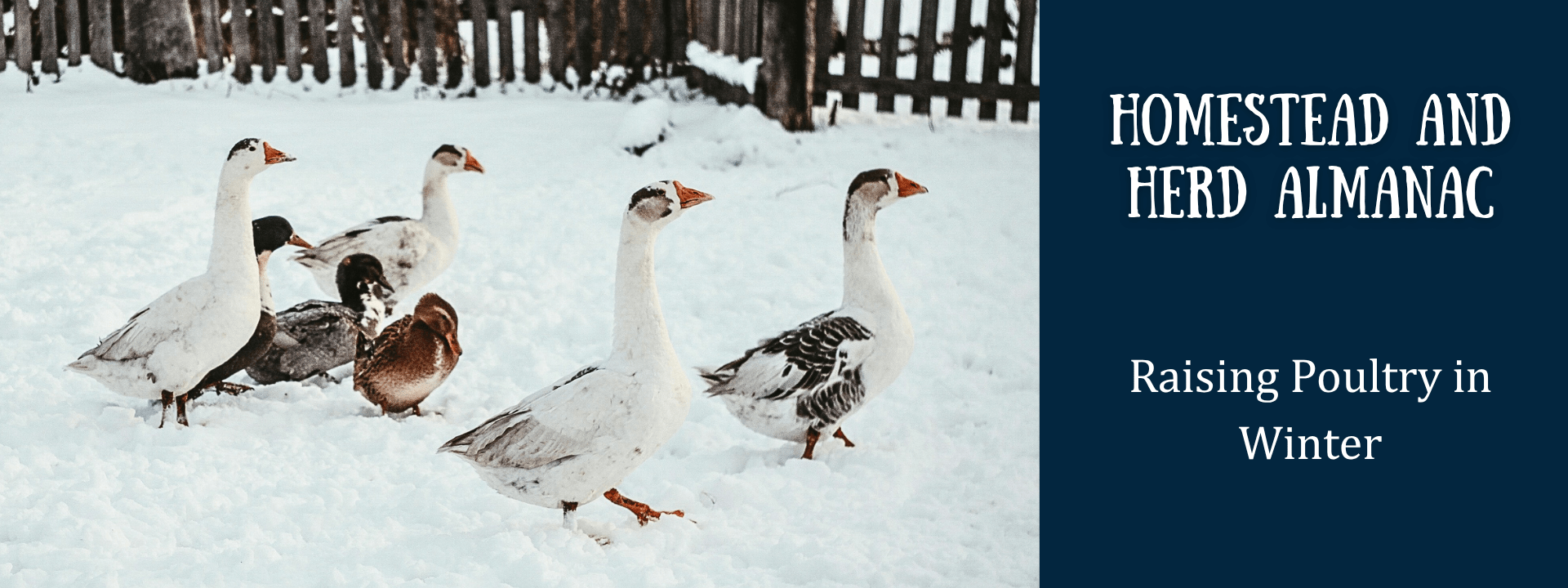
Raising Poultry in Winter: Keeping Your Flock Healthy, Warm, and Productive
Winter is one of the most demanding seasons for backyard poultry keepers. While most chickens can maintain their body temperature when the outside temperature sits between 60°-75°F, the average chicken’s internal temperature stays around 106°F – meaning they’re constantly working to generate heat when the weather turns cold. With thoughtful management, the right breeds, and a well-prepared coop, your flock can thrive even through harsh winter conditions.
Choosing the Right Winter-Hardy Breeds
Some breeds simply handle the cold better than others. Heavier, winter-hardy breeds such as Plymouth Rock, Wyandotte, Ameraucana, and Orpington tend to maintain body heat more effectively. Those birds have dense feathering and smaller combs, reducing their risk of frostbite.
Smaller or lighter breeds with sparse feathering, tall combs, or large wattles need extra care. Knowing your breeds limitations helps you prepare before the first snow falls.
Preparing the Coop for Winter Success
A warm flock starts with a well-designed coop.
Roosts Matter
Chickens roost to protect themselves from the cold ground. Roosts should be placed a minimum of 12 inches, through 2-3 feet off the floor is ideal for winter. When chickens settle on their feet, they over them with feathers, keeping them insulated. It’s common to see birds choose higher roosts more often than lower – even in draft-free coops – because warm air rises.
Draft-Free, Not Airtight
Cold air doesn’t hurt chickens – moisture does. Inspect your coop for cracks, gaps, and holes, sealing where necessary while keeping proper ventilation. Chickens produce humidity every time they breathe, and that moisture combined with cold in the main cause of moisture.
Insulate where you can, but keep insulation inaccessible. Many keepers have stories of curious chickens shredding exposed foam.
Deep Litter Method
One of my favorite winter tricks: the deep litter method. By building up layers of bedding that naturally compost, you create additional warmth and insulation throughout the season. You can also mix in coop herbs or natural deodorizers to help manage ammonia.
Feeding for Warmth and Energy
Chickens eat to meet energy needs – and in winter, those needs go up. Expect a 25-50% increase in feed intake.
High-Quality Feed
Protein, carbohydrates, and fats all play a role in energy production. During cold snaps, I’ve watched my flock noticeably increase consumption, especially in early mornings and late afternoons.
Scratch Grains
Scratch grains are a great tool, but not a full feed. Offer it late afternoon so the digestion process generates heat overnight. Ground or cracked corn is an excellent for this purpose.
Boredom Busters That Add Warmth
- Hay to dig through
- Safe root vegetables, squash, or pumpkins
- Seed blocks or flock blocks
(Be mindful – potatoes and certain vegetables are unsafe for poultry.)
Managing Nesting Boxes and Eggs in Winter
Freshly laid eggs average 109°, and because they contain so much water, they can freeze quickly in cold weather.
- Keep nest boxes clean and dry
- Collect eggs as soon as possible – most hens finish laying before noon
- Replace wet bedding immediately
Lighting Through Winter
Chickens need 14 hours of light for peak egg production. If you want to maintain winter laying:
- Use soft supplemental lighting – a 25-40W bulb or Christmas-style string lights
- Only add light in the morning, not at night
- Use a timer for consistency
- Adjust after December 20, when daylight naturally increases
Avoid fluorescent bulbs, and never use bright lighting that disrupts their natural rhythms.
Understanding Frostbite
Frostbite shows up most often on combs, wattles, and toes. You may see:
- Black or grey tissues
- Brittle Texture
- Swelling or blistering
Preventing frostbite is far easier than treating it. High moisture inside the coop is the root causes, so focus on ventilation. Applying petroleum jelly can help insulate exposed skin, but it does not treat frostbite.
Water, Grit and Other Winter Essentials
Fresh, Unfrozen Water
Chickens reduce feed intake without water – which reduces body heat. Heated waterers or frequent checks are a must.
Grit
When the ground freezes, natural grit becomes scarce. Offer a grit source year-round, but especially in winter.
Electrolytes
An occasional electrolyte boost supports hydration and overall winter wellness.
Use Sunlight as a Heat Source
Even with short winter days, sunlight is a free heat:
- Use insulated windows to create a “sun trap”
- Increase thermal mass – stone concrete or a deep litter compost layer absorb heat and release it slowly
- Create a winter “sunroom” in your run using greenhouse plastic or polycarbonate panels
Avoiding Heat Lamps – Why They Can Be Dangerous
Heat lambs create a false climate. Birds adapt to the warm spot, then become stressed – or even sick – when they step outside into real winter temperatures.
They also introduce major fire risk in dry coops. Instead, focus on:
- Proper insulation
- Ventilation
- Dry bedding
- Adequate nutrition
A healthy chicken flock can tolerate cold temperatures far better than many people realize.
Winter Isn’t Easy – But Your Flock Can Thrive
With the right setup, proper nutrition, draft-free housing, and awareness of how chickens naturally regulate hear, your birds can stay comfortable and productive all winter long. Many backyard keepers find winter to be one of the most rewarding seasons – your flock depends on you more, and you see the rewards in their health and resilience.
